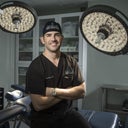Thank you for your question julie420. I understand your concern. Botox is a purified protein used to address wrinkles associated with facial expression. When injected into the skin Botox will relax the muscles and smoothen out the overlying wrinkles. The most common areas of treatment are in the upper face. These include the horizontal lines seen on the upper forehead when one raises the brows, the vertical lines seen between the brows when one frowns (frown lines), and the crow's feet seen around the eyes when one smiles.It is difficult to make an assessment in the absence of consistent photographs before and after in the same lighting and angles for comparison. However, I hope the information provided here is useful.Botox is a prescription strength medication that is injected into the skin or other areas. Therefore, it is important that the treatment is performed by a trained medical professional. This can be a physician, physician’s assistant, nurse practitioner, or nurse. Laws vary from jurisdiction to jurisdiction on who is allowed to provide the treatment. In California, for example, any of these aforementioned medical professional is permitted to provide a treatment. With the recent explosion of cosmetic medicine, there are more and more people offering such services. This includes core physicians such as plastic surgeons and dermatologists as well as other physicians who are trained in cosmetic treatments such as general physicians, gynecologists, or other specialists. It is important to understand that just because a doctor is a plastic surgeon or dermatologist does not necessarily make them an expert on Botox. General doctors who routinely perform Botox treatments multiple times per day likely have more experience and expertise than a plastic surgeon who spends most of his time performing surgeries and performs perhaps only a single Botox treatment per month. Similarly, there are many outstanding nurse injectors who spend their entire days performing cosmetic treatments, as they are often delegated to nurses. Their experience can at times be great than that of many doctors.I recommend against purchasing Botox online because much of it is counterfeit, especially those that can be found for discounted prices. Further, as described above, it should be administered by a trained professional to avoid side effects.The safety record of Botox is well established. The product has been used for over 20 years for a variety of treatments with minimal side effects. Botox is amongst the safest treatments for treating facial wrinkles.While Botox is one of the safest treatments offered, there are some situations where it is not appropriate. These include anyone who has an allergy to any of the inactive ingredients or who has had an allergic reaction to any botulinum product including Botox, Dysport, Xeomin, or Myobloc. The safety and efficacy of Botox has not been established in women who are pregnant, trying to become pregnant, or breast feeding. Therefore, women in these categories are advised to wait until breast feeding is completed prior to having a Botox treatment. Botox should not be placed in the skin on the site of an infection. Those who are taking an aminoglycoside antibiotic, an anesthetic, D-penicillamine, antimalarials, or immunosuppressants should not be treated, nor should those who have undergone chemotherapy within the previous six months. It is important to avoid blood thinners before and after a treatment. These include both prescription and non-prescription medications such as warfarin (coumadin), aspirin, ibuprofen, alcohol, fish oil, vitamin E, and ginko biloba. Those with conditions that affect muscles and nerves such as amyotrophic lateral sclerosis (ALS or Lou Gehrig's disease), myasthenia gravis, or Lambert-Eaton syndrome should not undergo Botox treatments.With any injection, there are risks such as pain, bleeding, bruising, redness, swelling, tenderness, and infection. We take special precautions to minimize these risks such as using a painless technique. We also treat bruises with a laser as early as the next day. Bruises usually resolve within two weeks if untreated. After a laser treatment bruises usually resolve in 1-3 days, but may still take two weeks for full resolution. In addition to these risks, with Botox there is also a risk that the product spreads or diffuses to nearby structures. Spread to nearby muscles can lead to side effects such as the temporary appearance of droopy eyelids or a temporary asymmetric smile.













